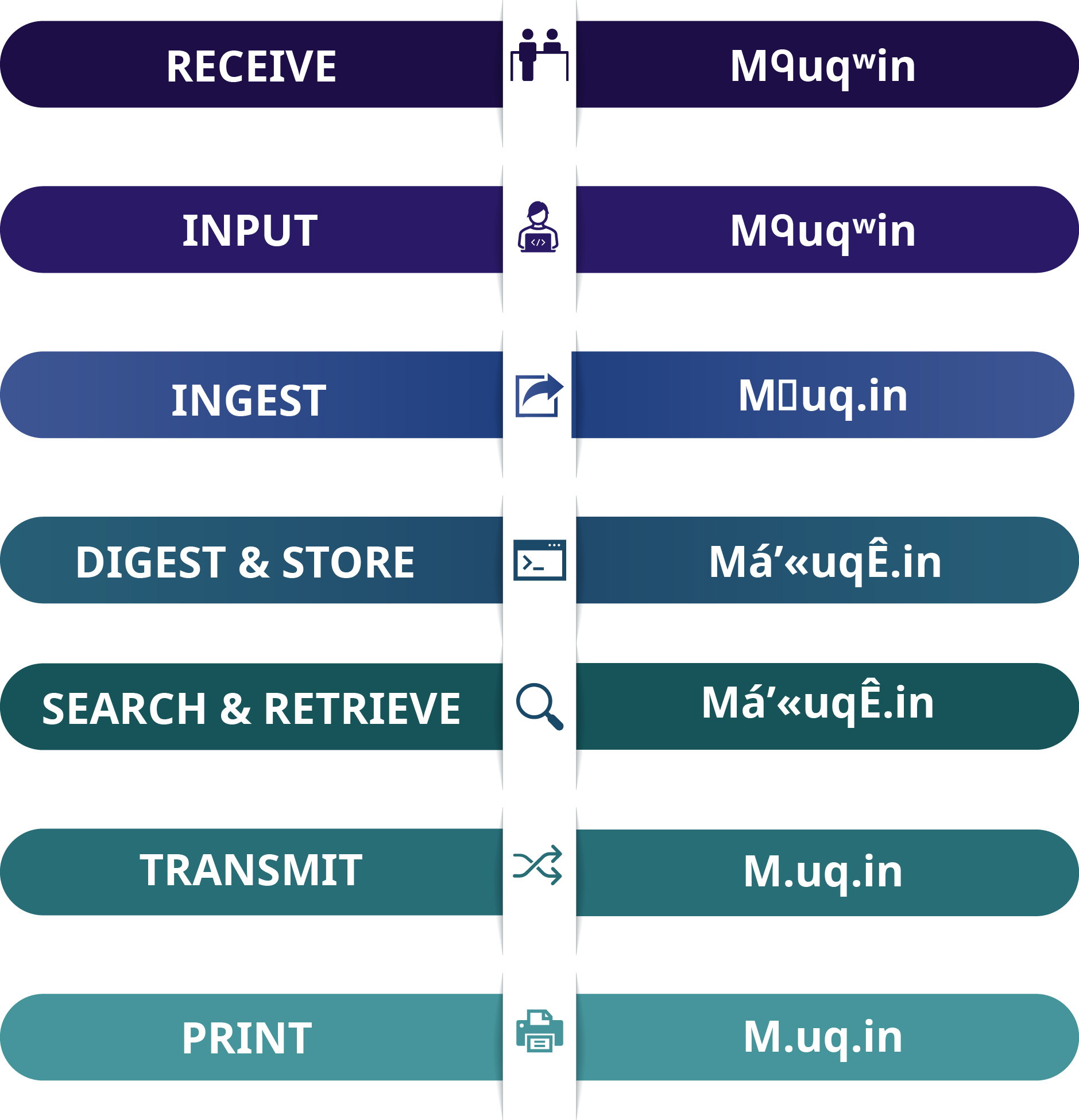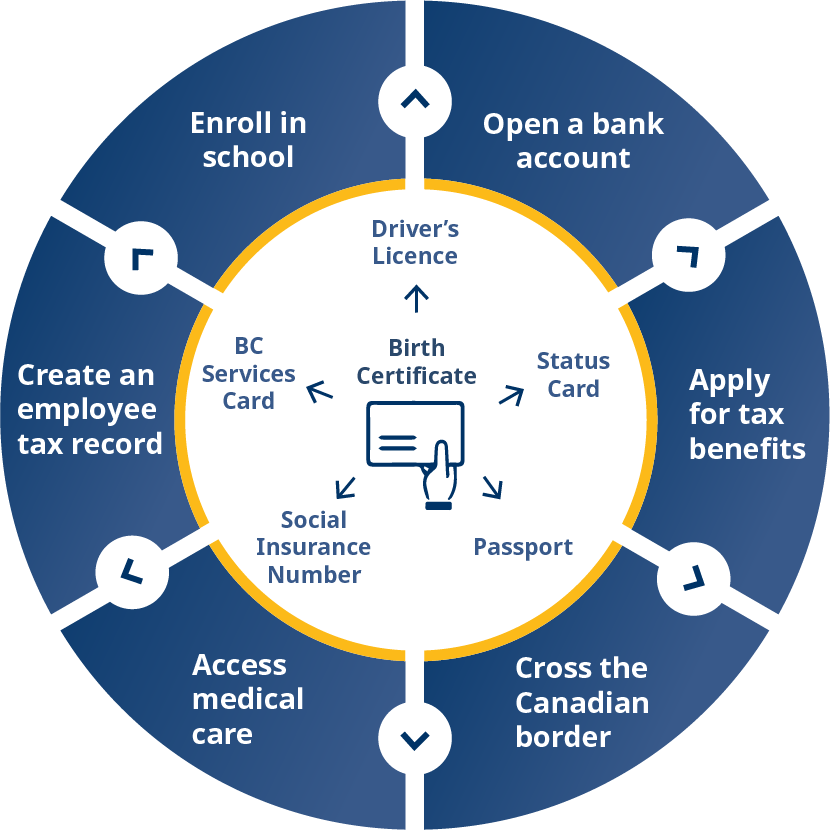Including Indigenous languages in government records, systems and services
The Province is taking steps to include First Nations, Métis and Inuit languages in official government records, systems and services. Find out what steps are being taken and how you can stay informed.
On this page
- Recognizing the past and including Indigenous languages
- Managing updates across interconnected systems
- Tools and technology needed for inclusive records, system and services
- Implementation timeline
- Transition to Indigenous names on identification
- New standards for government systems
- Guidance to support Indigenous languages
- Contact us
- Resources
Subscribe to this page to stay informed about this work.

Eagle feather artwork by Andy Everson
Recognizing the past and including Indigenous languages
Canada’s colonial legacy includes a history of policies and practices – such as assimilation, forced relocation, the Sixties Scoop and residential schools. These policies and practices were detrimental to Indigenous languages and contributed to their erosion.
European settlers replaced the names of First Nations’ territories (places) with anglicized names. Indigenous people also had their names forcibly changed to anglicized names. This continues to impact Indigenous people today. It has resulted in a system where individuals are unable to use an Indigenous language name on official documents like:
-
Birth certificate
-
Driver's licence
-
Business licence
Managing updates across interconnected systems
There are significant changes needed to update government records and data systems. Most government services use technology that can't record or transmit characters beyond the Latin alphabet. It gets more complicated because many government systems are connected and depend on each other. If one system in the chain can't process or store the data, it can disrupt people's access to services.
The Province is engaging with Indigenous Peoples to find solutions to include Indigenous languages across government systems and services. This will include changes to:
- Legislation
- Policy
- Technology
- Service delivery
To ensure people can access services, names on identity documents and in systems need to match.
A good example is how a person's name on their identification impacts connected government systems.
To get a BC Services Card a person typically uses a birth certificate. The challenge arises when the birth certificate contains Indigenous language characters that the existing systems are unable to record.
- Social insurance number
- Driver's licence
- Passport
- Other forms of identification
Updating one system to include Indigenous languages requires considering the impacts on all connected systems. In just the B.C. core government, there are over 1,200 systems that need technological updates. While we upgrade technology, we are working on solutions to ensure that individuals with Indigenous language names can access services seamlessly.
Most government systems will be affected
Changes to incorporate Indigenous languages will affect nearly every government information system. This is true whether a person wants to record an Indigenous-language name for:
- A person
- A business
- A location
The complexity of this work and the need to maintain access to essential services for people means that the Province must proceed carefully. Indigenous peoples must be engaged to drive the priorities and path forward.
Tools and technology needed for inclusive records, systems and services
Including Indigenous languages in government records, systems, and services requires specialized tools. Computer systems can distort a name with Indigenous characters without the right:
- Font
- Database
- Software
- Code
- Keyboards
Indigenous name data journey
The example below illustrates the challenges in correctly displaying a name during data processing when the proper technology isn’t in place. To correctly document a name with Indigenous characters specific technology is required.

Step 1 - Receive: Client provides ID with their Indigenous language name
Step 2 - Input: The name is entered into a system using a keyboard
Step 3 - Ingest: The system saves the name in a database. If encoding is inadequate, some characters may be altered, omitted, or replaced
Step 4 - Digest and Store: Different systems with varying encoding capabilities may introduce further alterations to characters
Step 5 - Search and Retrieve: Staff searches for the name, and the system retrieves and sends it to the print system
Step 6 - Transmit: The print software reads the name from the database and and may misspell it if the encoding isn’t recognized during data exchange
Step 7 - Print: The printed intake report is filed, but encoding issues may cause name errors like missing or incorrect characters
With the right tools in place the name will be maintained at each step in the data journey from entry to print.
Using an inclusive font
- Learn about and download BC Sans
How are we doing this work?
We are working in consultation and cooperation with Indigenous Peoples. Together we will set priorities and develop solutions. This work is happening through two parallel streams of work.
Updating services
Work is starting on the name type that we’ve heard is the most important to Indigenous Peoples – person names on identity documents and the associated services. After that, work will begin on business names and location names as outlined below:
- Personal Identity Documents and Services: Documents, such as birth certificates and driver's licences, and services requiring these documents
- Business Names: Registering a business under the Corporations Act using an Indigenous name
- Location Names: Geographical features and other place names reflected on maps, websites and forms
Modernizing technology
At the same time, we are working to ensure all government technology can support Indigenous languages.
Implementation timeline
More than 1,200 government systems will be modernized to support Indigenous languages. Significant changes are needed to laws, policies, technology and how we deliver services.
July 2027:
- Register a new birth or change a name to an Indigenous name
- Get a BC Services Card in Indigenous languages
- Register an Indigenous business name
January 2029:
- Use an Indigenous name when accessing a core set of government services, as prioritized with Indigenous Peoples
- Begin seeing place names in Indigenous languages on maps, websites, and forms
January 2034:
- Use Indigenous language names in all interactions with the B.C. government
Transition to Indigenous names on identification
Soon there will be a way to have an Indigenous language name on identification and still access services. We are making changes so that a person's identification would include two names.
- The Indigenous language name, and
- A name the uses the current (Latin) characters. This name would be selected by the individual or parent/guardian.
Using two names will smoothen the transition to using only an Indigenous language name. We are working with Indigenous Peoples to co-develop the specifics of this option as per the above timelines.
We’re investing to make sure all our technology supports Indigenous languages in the future.
The Indigenous Languages Technology Standard (ILTS) outlines the requirements for government systems. It requires systems to read, write, store, process, and display Indigenous languages. This standard applies to each individual system. It is the first in a series of technical standards required to create seamless access to services using an Indigenous language name. This standard is available for all organizations to use and reference in updating their systems.
- Read more about the Indigenous Languages Technology Standard
- Find guidance to building and maintaining systems that support Indigenous languages
Contact us
For more information, contact Eowynn Bosomworth, Executive Director, B.C. Data Systems and Services
- Email: Eowynn.Bosomworth@gov.bc.ca
Resources
- 2021 Letter of Intent between the Province and Métis Nation British Columbia
- Shared Priorities Framework - Province of British Columbia & Alliance of BC Modern Treaty Nations
- Download First Voices Keyboard and Language Apps for Android and iPhone
- Download Michif to Go for Android or Apple
- Download Northern Michif to Go for Android or Apple
- Legal name change - Information about name changes can be found on the B.C.’s Vital Statistics Agency website
- Indigenous language name for a geographical place - Requests an Indigenous-language name for a geographical place from the BC Geographical Names Office
- Watch the First Peoples Cultural Council video Supporting Indigenous Names and Alphabets with Technology
Subscribe
Enter your email address to subscribe to updates of this page.

